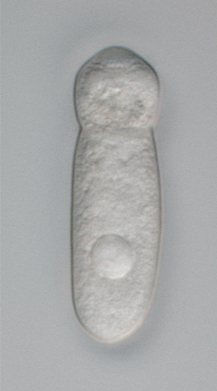Related Research Articles

The Apicomplexa are a large phylum of mainly parasitic alveolates. Most of them possess a unique form of organelle that comprises a type of non-photosynthetic plastid called an apicoplast, and an apical complex structure. The organelle is an adaptation that the apicomplexan applies in penetration of a host cell.

The gregarines are a group of Apicomplexan alveolates, classified as the Gregarinasina or Gregarinia. The large parasites inhabit the intestines of many invertebrates. They are not found in any vertebrates. Gregarines are closely related to both Toxoplasma and Plasmodium, which cause toxoplasmosis and malaria, respectively. Both protists use protein complexes similar to those that are formed by the gregarines for gliding motility and for invading target cells. This makes the gregarines excellent models for studying gliding motility, with the goal of developing treatment options for both toxoplasmosis and malaria. Thousands of different species of gregarine are expected to be found in insects, and 99% of these gregarine species still need to be described. Each insect species can be the host of multiple gregarine species. One of the most-studied gregarines is Gregarina garnhami. In general, gregarines are regarded as a very successful group of parasites, as their hosts are distributed over the entire planet.

Lepismatidae is a family of primitive wingless insects with about 190 described species. This family contains the two most familiar members of the order Zygentoma: the silverfish and the firebrat. It is one of five families in the order Zygentoma.

Conoidasida is a class of parasitic alveolates in the phylum Apicomplexa. The class was defined in 1988 by Levine and contains two subclasses – the coccidia and the gregarines. All members of this class have a complete, hollow, truncated conoid. Gregarines tend to parasitize invertebrates with the mature gamonts being extracellular; the coccidia mostly infect vertebrates and have intracellular gamonts.

Adeleorina is a suborder of parasites in the phylum Apicomplexa.
The Archigregarinorida are an order of parasitic alveolates in the phylum Apicomplexa. Species in this order infect marine invertebrates — usually annelids, ascidians, hemichordates and sipunculids.
The Neogregarinorida are an order of parasitic alveolates in the phylum Apicomplexa. Species in this order infect insects and are usually found in the fat body, hemolymph, hypodermis, intestine or Malpighian tubules. The most common site of infection is the fat body: many species are pathogenic for their hosts.
The Eugregarinorida are the most large and diverse order of gregarines — parasitic protists belonging to the phylum Apicomplexa. Eugregarines are found in marine, freshwater and terrestrial habitats. These species possess large trophozoites that are significantly different in morphology and behavior from the sporozoites. This taxon contains most of the known gregarine species.
A mucron is an attachment organelle found in archigregarines - an order of epicellular parasitic Conoidasida.
Siedleckia are a genus of parasitic alveolates in the phylum Apicomplexa. Species in this genus infect marine invertebrates.
Aseptatorina is a suborder of parasitic alveolates of the phylum Apicomplexa
Allantocystis is a genus in the family Allantocystidae. Its only species is Allantocystis dasyhelei, a gregarine parasite of the larval biting midge Dasyhelea obscura.
The Ganymedidae are a family of parasites in the phylum Apicomplexa.
Apicystis is a genus of parasitic alveolates of the phylum Apicomplexa.
Lipotropha is a genus of parasitic alveolates of the phylum Apicomplexa.
Siedleckiidae is a family of parasitic alveolates in the phylum Apicomplexa. Species in this family infect marine invertebrates.
The Rhynchocystinae are a subfamily of parasites in the phylum Apicomplexa.
Nematopsis (Nee-mah-top-cis) is a genus gregarine Apicomplexan of the family Porosporidae. It is an aquatic parasite of crustaceans with a molluscan intermediate host. Nematopsis has been distinguished from the similar genus Porospora by its resistant and encapsulated oocyst. Little molecular biology has been performed on the members of the Nemaptosis and species are described based on molluscan and crustacean hosts as well as oocyst structure. A total of 38 species have been described and are found all over the world.

Gregarina garnhami is a eukaryotic unicellular organism belonging to the Apicomplexa described in 1956 by Canning as a parasite found in several locusts, such as the desert locust, African migratory locust, and Egyptian locust. Especially, the desert locust is the host for this species, as up to 100% of animals can become infected. An estimated thousands of different species of gregarines can be in insects and 99% of these gregarines still need to be described. Each insect is said to host multiple species. A remarkable feature of G. garnhami is its autofluorescence.
Plebeiogryllus guttiventris is a species of Orthoptera in the family Gryllidae. Two subspecies are recognized. It can be found in India.
References
- ↑ Codreanu M (1940) Sur quatre grégarines nouvelles du genre Enterocystis, parasites des éphémères torrenticoles Arch Zool Exp Gén (Notes et Revue) 81: 113-122
- ↑ Sarkar, N. K. (April 20, 1983). "ENTEROCYSTIS BENGALENSIS N. SP. (APICOMPLEXA : ENTEROCYSTIDAE) FROM PSOCATROPOS SP. (PSOCOPTERA) OF WEST BENGAL, INDIA". Current Science. 52 (8). Retrieved 1 January 2022.
- ↑ Desportes, I.; Schrével, J. (2013). Treatise on Zoology - Anatomy, Taxonomy, Biology. The Gregarines (2 vols): The Early Branching Apicomplexa. Treatise on Zoology - Anatomy, Taxonomy, Biology - The Gregarines. Brill. p. 3. ISBN 978-90-04-25605-7 . Retrieved 2022-01-01.